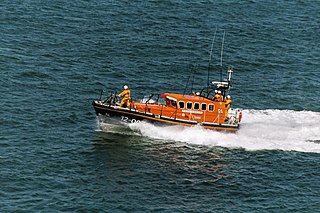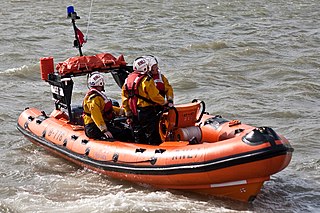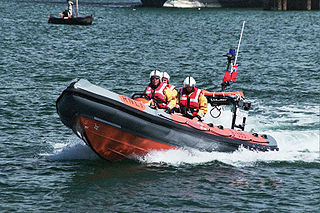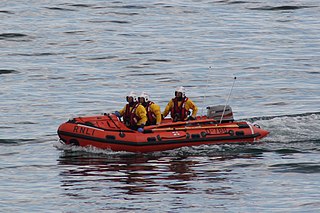
The Severn class is the largest lifeboat operated by the Royal National Lifeboat Institution (RNLI). The class, which is 17.3 metres long, was introduced in to service in 1996. It is named after the River Severn, the longest river in Great Britain. The lifeboats are stationed at 35 locations around the coasts of the United Kingdom and Ireland and can provide coverage up to 125 nmi (232 km) out to sea.

Mersey-class lifeboats are all-weather lifeboats operated by the Royal National Lifeboat Institution (RNLI) from stations around the coasts of Great Britain and Ireland, and 3 former RNLI boats operated by ADES Uruguay. They are capable of operating at up to 17 knots (31 km/h) and can be launched from a carriage or by slipway.

The Tyne-class lifeboat was a class of lifeboat that served as a part of the Royal National Lifeboat Institution fleet until 2019. They were named after the River Tyne in North East England.

The Atlantic 75 is part of the B-class of lifeboats that serve the shores of the United Kingdom as a part of the RNLI inshore fleet.

The Atlantic 85 is part of the B-class of lifeboats that serve the shores of the United Kingdom and Ireland as a part of the RNLI inshore fleet.

The Atlantic 21 is part of the B class of lifeboats that served the shores of the United Kingdom and Ireland as part of the Royal National Lifeboat Institution (RNLI) inshore fleet. The Atlantic 21 was the first generation rigid inflatable boat (RIB), originated at and by Atlantic College in South Wales, the birthplace of the RIB after which the craft is so named. The school was also one of nine locations where the RNLI first established lifeboat stations using smaller inshore watercraft. Atlantic College Lifeboat Station was commissioned by the RNLI in 1963 and decommissioned in 2013.

The Shannon-class lifeboat is the latest class of lifeboat currently being deployed to the RNLI fleet to serve the shores of the British Isles. The Shannon class is due to replace the Mersey class and some Trent-class lifeboats.

The D-class (IB1) lifeboats are inflatable boats serving in the RNLI inshore lifeboat (ILB) fleet as well as a number of Independent Lifeboats around the UK and Ireland. Although they are known as the "IB1" at times, they are the latest development of the D-class lifeboat and as such are mainly referred to as a "D-class".

Walmer Lifeboat Station was established in 1830. Over two thousand ships are believed to have been wrecked on the Goodwin Sands, and the masts of several wrecks are visible from the shore at low tide. Hence there have always been two lifeboats located at the joined towns of Deal and Walmer along the coast opposite the sands.

Teddington Lifeboat Station is a lifeboat station in Teddington, in west London, on the River Thames. It is one of the Royal National Lifeboat Institution (RNLI)'s newest lifeboat stations and is also one of the first to cover a river rather than estuarial waters or the sea. Teddington Lock is the highest tidal point on the Thames.

Fowey Lifeboat Station is the base for Royal National Lifeboat Institution (RNLI) search and rescue operations at Fowey on the south coast of Cornwall in the United Kingdom. The first lifeboat was stationed in the area in 1859 and the present station was opened in 1997. It operates a Trent Class all weather boat (AWB) and a D class (IB1) inshore lifeboat (ILB).

Appledore Lifeboat Station is the base for Royal National Lifeboat Institution (RNLI) search and rescue operations at Appledore, Devon in the United Kingdom. The first lifeboat was stationed in the town in 1825 and the present station was opened in 2001. It operates a Tamar-class all-weather boat (AWB) and an Atlantic 85 B Class inshore lifeboat (ILB).

Minehead Lifeboat Station is the base for Royal National Lifeboat Institution (RNLI) search and rescue operations at Minehead, Somerset in England. The first lifeboat was stationed in the town in 1901 but since 1976 two inshore lifeboats (ILBs) have been operated, a B Class rigid-hulled boat and an inflatable D Class.

Burnham-on-Sea Lifeboat Station is the base for Royal National Lifeboat Institution (RNLI) search and rescue operations at Burnham-on-Sea, Somerset in England. A lifeboat was stationed in the town from 1836 until 1930. The present station was opened in 2003. It operates two inshore lifeboats (ILBs), a B-Class rigid-inflatable boat and an inflatable D-Class.

Calshot Lifeboat Station is located on Calshot Spit near the village of Calshot, Hampshire, and is on the southern bank of the open end of Southampton Water, on the south coast of England. The station is owned and operated by the Royal National Lifeboat Institution (RNLI) and operates two inshore lifeboats: an B-class and a D-class (IB1).
The D-class lifeboat was a sub-class of 4 inflatable boats operated as part of the D-class between 1971 and 1986 by the Royal National Lifeboat Institution of the United Kingdom and Ireland. It was superseded by the D-class lifeboat.
The D-class lifeboat is a class of inflatable boat operated between 1971 and 1996 by the Royal National Lifeboat Institution of the United Kingdom and Ireland. It was replaced operationally by the D-class (EA16).
The D-class lifeboat is a class of inflatable boat operated between 1967 and 1983 by the Royal National Lifeboat Institution of the United Kingdom and Ireland.
The D-class (Dunlop) lifeboat is a class of inflatable boat operated between 1964 and 1969 by the Royal National Lifeboat Institution of the United Kingdom and Ireland.














